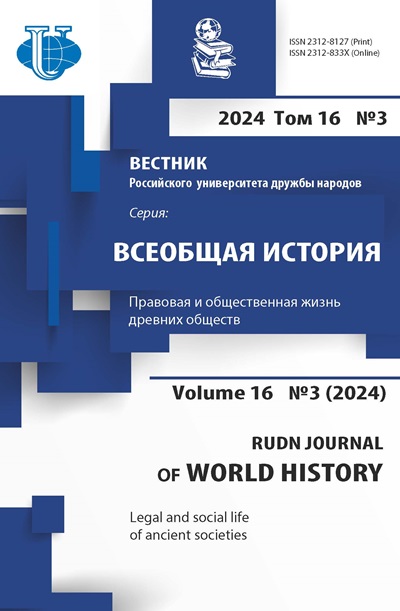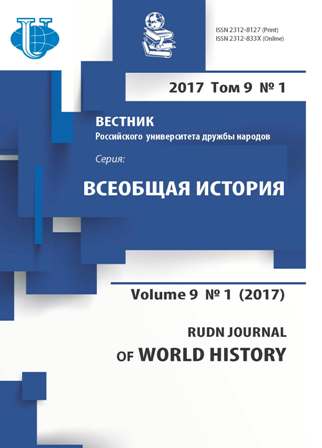THE TORGUTS: ON THE ISSUE OF ETHNOGENESIS AND RELIGIOUS ORIENTATION
- Authors: Kitinov BU1
-
Affiliations:
- Peoples’ Friendship University of Russia
- Issue: Vol 9, No 1 (2017)
- Pages: 84-95
- Section: Этнологические исследования
- URL: https://journals.rudn.ru/world-history/article/view/15831
- DOI: https://doi.org/10.22363/2312-8127-2017-9-1-84-95
Cite item
Full Text
Abstract
Torguts were a part of four-part Oirat Union (West Mongolians). For the first time they were mentioned in connection with the organization of the empire of Genghis Khan as his personal guard (turhaut-keshigten), and information about them are kept in the sources for the history of the different Asian countries. The guard was composed by the representatives of different nationalities, but it’s basis, apparently, was of Kerayit people, who were Nestorians. According to European medieval legend, with Wang Khan, the head of Kerayits, was related the existence of the East Christian kingdom of Prester John. Turhaut-keshigtens, who lived in East Turkestan, for two or three centuries, ie by the middle of the XV century, formed a Torguts ethnicity from the military class, and then entered into the composition of Oirats. Their further ethnic and religious history has been linked to the events that took place on the vast territory from the Caspian Sea to Mongolia and Tibet. Torguts have created, with the complicity of other Oirat tribes, the Kalmyk Khanate in Russia; they were the influential players in the historical development of Tibetan Buddhism, and their heads received the title of “Khan” from Dalai Lama. The development of events, evidently favorable to Torguts and other Oirats at the first years of the XVIII century, at the second half of the same century resulted in the disappearance of their khanates, the significant casualties, the elimination of political and other independence.
Keywords
About the authors
B U Kitinov
Peoples’ Friendship University of Russia
Author for correspondence.
Email: kitinov@mail.ru
Miklukho-Maklay St., 10-2, Moscow, 117198
References
- Avljaev G.O., Sanchirov V.P. K voprosu o proishozhdenii torgoutov i hoshoutov v jetnicheskom sostave srednevekovyh ojratov Dzhungarii (k probleme jetnogeneza kalmykov) [On the origin of Torgouts and Hoshouts in the ethnic composition of medieval irats of Dzungaria (to the problem of ethnogenesis of Kalmyks)] // Problema jetnogeneza kalmykov [The problem of ethnogenesis of Kalmyks]. Elista, 1984.
- Avljaev G.O. Proishozhdenie kalmyckogo naroda [The origin of the Kalmyk people].Moscow-Elista, 1994.
- Bakunin V.M. Opisanie kalmyckih narodov, a osoblivo iz nih togoutskogo, i postupkov ih hanov i vladel’cev [Description of the Kalmyk people, and especially of them Torgouts, and actions of their khans and owners]. Elista, 1995.
- Bartol’d V.V. Sochinenija. T. 5 [Works. Vol. 5]. M., 1968.
- Besprozvannyh L.E. Lidery Tibeta i ih rol’ v tibeto-kitajskih otnoshenijah XVII–XVIII vv.Volgograd [The leaders of Tibet and their role in the Tibetan-Chinese relations XVII– XVIII centuries]. Volgograd, 2001.
- Gaban Sharab. Skazanie ob ojratah [Legend on the Oirats] // Kalmyckie istoriko-literaturnye pamjatniki v russkom perevode [The Kalmyk historical and literary monuments in the Russian translation]. Elista, 1969.
- Dugarov R.N. “Djebtjer-Chzhamco” – istochnik po istorii mongolov Kuku-nora [“Debter-Chzhamtso” – a source for the history of the Mongols of Kuku-nor]. Novosibirsk, 1983.
- Istorija Kukunora, nazyvaemaja “prekrasnye noty iz pesni Brahmy”. Sochinenie Sumba Hambo [History of Kukunor, called as “The beautiful notes of the song of Brahma”. The work of Sumba Hambo]. Per. s tibet., vved. i primech. B.D. Dandarona [Trans. from Tibetan, introduction and notes by B.D. Dandaron]. Moscow, 1972.
- Kukeev D.G. O vhozhdenii torgutov i hoshutov v ojratskij sojuz (XV v.) [On the occurrence of Torguts and Khoshuts into Oirat Union (XV century)] // Pis’mennye pamjatniki Vostoka [The written monuments of the East]. 2008. 2 (9). P. 231–236.
- Kozin S.A. Sokrovennoe skazanie. Mongol’skaja hronika 1240 g. “Juan’ chao bi shi” [The Secret History. Mongolian Chronicle of 1240 “Yuan chao bi shi”]. Moscow–Leningrad, 1941.
- Kychanov E.I., Savickij L.S. Ljudi i bogi Strany snegov [Humans and gods of Snow Lands]. Moscow, 19
- Luvsandjendjev A. Otnositel’no kalmyckogo slova tangch [Concerning of the Kalmyk word Tangch] // V Mezhdunarodnyj Kongress mongolovedov. Doklady rossijskoj delegacii [V International Congress of the Mongolists. Reports of the Russian delegation]. Vol. 2. Moscow, 1992.
- Lytkin Ju. Istorija kalmyckih hanov [The history of Kalmyk Khans] // Kalmyckie istoriko-literaturnye pamjatniki v russkom perevode [The Kalmyk historical and literary monuments in the Russian translation]. Elista, 1969.
- Lytkin Ju.S. Ajuki – han kalmyckij [Ayuka – the Kalmyk Khan]. URL: http://www.vostlit.info/Texts/Dokumenty/Mongol/Lunnij_svet/text14.phtml?id=12315.
- Nominhanov C.D. Proishozhdenie jetnonima “kalmyk” [The origin of the ethnonym “Kalmyk”] // Vestnik AN Kaz.SSR [The Bulletin of the Academy of Sciences of the Kazakh SSR]. 1958. № 11.
- Pagsam-dzhonsan: Istorija i hronologija Tibeta [History and Chronology of Tibet]. Per. s tibet. jaz., predisl., komment. R.E. Pubaeva [Trans. from Tibetan, foreword, comments by R.E. Pubaev]. Novosibirsk, 1991.
- Sandag Sh. Obrazovanie edinogo mongol’skogo gosudarstva i Chingishan [The formation of the united Mongolian state and Genghis Khan] // Tataro-mongoly v Azii i Evrope [Tatar-Mongols in Asia and Europe]. M., 1970.
- Sanchirov V.P. “Iljethjel-shastir” kak istochnik po istorii ojratov [“Ilethel-shastir” as a source for the history of Oirats]. M., 1990.
- Skazanie o derben-ojratah, sostavlennoe nojonom Batur-Ubushi Tjumenem [The Legend on Derben-Oirats, composed by noyon Batur-Ubushi Tyumen // Kalmyckie istorikoliteraturnye pamjatniki v russkom perevode [The Kalmyk historical and literary monuments in the Russian translation]. Elista, 1969.
- Uspenskij V. Strana Kukje-nor ili Cin-haj, s pribavleniem kratkoj istorii ojratov i mongolov po izgnanii poslednih iz Kitaja v svjazi s istoriej Kukje-nora [Country of Kuke-noror Qing-hai, with the addition of a brief history of the Oirat Mongols after their exile from China and in connection with the history of Kuke-nor]. SPb., 1880.
- Hojt S. Jetnicheskaja istorija ojratskih grupp [The ethnic history of Oirat groups]. Elista, 2015.
- The Autobiography of the first Panchen Lama Blo-bzang-chos-kyi-rgyal-mtshan. 1567–1662. Ed. and intr. by Ngawang Gelek Demo. New Delhi, 1969.
- Das S.Ch. Tibetan Studies. New Delhi, 1984.
- Elverskog J. Our Great Qing. The Mongols, Buddhism and the State in Late Imperial China. University of Hawai’i Press, 2010.
- Howorth H. History of the Mongols from the IX-th to the XIX-th Century. Pt. l. The Mongols proper and the Kalmuks. L., 1876.
- Ishihama Yumiko. A Study of the Seals and Titles Conferred by the Dalai Lamas // Tibetan Studies. Proceedings of the V Seminar of the International Association for Tibetan Studies. Narita, 1989. Vol. 2. Naritasan shinshoji, 1992.
- Kitinov Baatr. Buddhism and Polity in Caspian Region // Himalayan and Central Asian Studies. 2016. Vol. 20. № 1. P. 26–40.
- Krueger J. New Materials on Oirat Law and History. Pt. 2. The origin of the Torgouts // Central Asiatic Journal. 1974. Vol. XVIII. № 1. P. 30–42. According to: [28. С. 233].
- Pallas P.S. Sammlungen historischer Nachrichten über die mango-lischen Volkerschaften. T. 1. SPb., 1776.
- Pelliot P. Notes Critiques d’Histoire Kalmouke. Pt. 1–2. P., 1960.
- Richardson H. The Karma-pa Sect. A Historical Note // Journal of Asian Studies. 1958. October.
- Turgut Turhan. Unutulan Budistler. Cin – Rusya arasinda Turgutlar // Toplumsal Tarih. 2013. № 234.













